Automatic Labeling Machine Market Size and Share
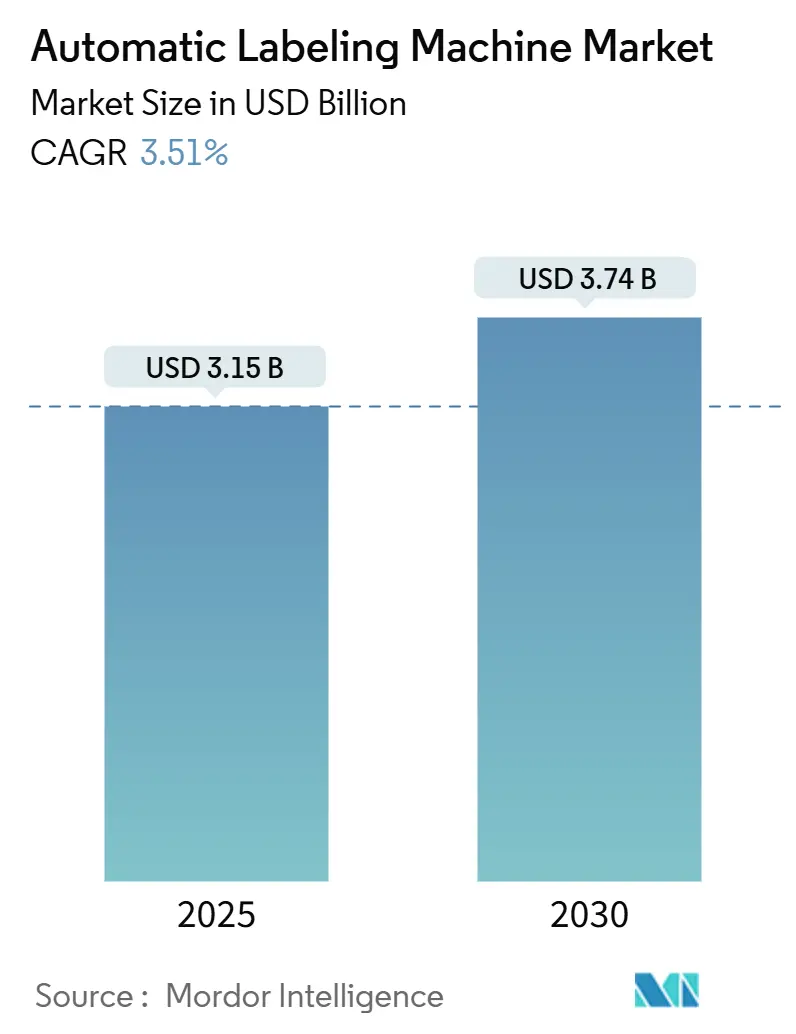
Automatic Labeling Machine Market Analysis by Mordor Intelligence
The automatic labeling machine market size generated USD 3.06 billion in 2024 and is projected to advance to USD 3.74 billion by 2030 while registering a 3.51% CAGR. The outlook reflects a maturing but steadily expanding sector where regulatory compliance, plant-level automation, and smart packaging features continue to stimulate equipment upgrades. Heightened serialization rules in pharmaceuticals, craft beverage SKU proliferation, logistics automation, and linerless sustainability mandates all reinforce equipment demand. Competitive differentiation now hinges on integrating RFID/NFC functionality, AI-driven quality control, and predictive maintenance to lower downtime and total cost of ownership. Volatile adhesive and label-stock pricing plus technician shortages remain limiting factors, yet most end users keep automation investments in place because compliance deadlines are non-negotiable and throughput pressures persist.
Key Report Takeaways
- By technology, pressure-sensitive systems led with 39.84% revenue, and sleeve machines posted the quickest 5.65% CAGR through 2030.
- By machine configuration, in-line units held 62.54% of the automatic labeling machine market share in 2024, while modular platforms are forecast to expand at 6.36% CAGR.
- By labeling speed, the 61-200 BPM band accounted for 45.34% of the automatic labeling machine market size in 2024; the 201-400 BPM category is projected to rise 7.07% CAGR to 2030.
- By end user, beverages represented 27.45% of 2024 demand, and pharmaceuticals are pacing fastest at 7.68% CAGR.
- By geography, Asia-Pacific dominated with a 40.36% share and remains the quickest-growing region at 6.35% CAGR.
Global Automatic Labeling Machine Market Trends and Insights
Drivers Impact Analysis
| Driver | (~) % Impact on CAGR Forecast | Geographic Relevance | Impact Timeline |
|---|---|---|---|
| Rising demand for smart packaging traceability | +1.2% | Global, with early adoption in North America & EU | Medium term (2-4 years) |
| Surge in craft beverage short-run SKUs | +0.8% | North America & Europe core, expanding to APAC | Short term (≤ 2 years) |
| Growth of e-commerce fulfillment centers | +0.9% | Global, concentrated in urban logistics hubs | Medium term (2-4 years) |
| Stricter serialization/UDI rules (pharma and med-device) | +1.1% | Global, led by FDA/EMA jurisdictions | Long term (≥ 4 years) |
| Digital print-on-demand integration | +0.7% | Developed markets initially, spreading to emerging economies | Medium term (2-4 years) |
| Sustainability-driven shift to linerless labels | +0.6% | Europe leading, followed by North America and APAC | Long term (≥ 4 years) |
| Source: Mordor Intelligence | |||
Rising Demand for Smart Packaging Traceability
Brand owners now see labeling as an authentication and consumer-engagement touchpoint. Blockchain traceability programs oblige every item to carry a unique digital identity, nudging purchasers toward print-and-apply systems with vision verification and RFID encoding. Pharma producers comply because serialized packs are mandatory, while food and personal-care brands leverage QR codes for recipe data, loyalty campaigns, and anti-counterfeit assurance. Line builders thus embed IoT sensors plus AI algorithms to validate codes in real time and feed ERP systems with granular production data. The upcoming EU Digital Product Passport law will cement smart labels as a baseline requirement rather than a premium feature. Consequently, capital budgets increasingly prioritize connectivity and data integrity over raw throughput.
Surge in Craft Beverage Short-Run SKUs
Independent breweries and specialty drink brands push unprecedented flavor rotations and seasonal packaging. Batch volumes of 500–5,000 units demand presses that change formats in minutes instead of hours. Modular heads and servo-controlled feeders minimize downtime, while integrated digital printers handle variable graphics without storing pre-printed rolls. Adoption is strongest in the United States and Western Europe, but is now visible in the Australian and Japanese craft segments. Suppliers respond with compact systems combining printing, tamper-band application, and camera inspection within a single skid. Such versatility allows smaller producers to launch niche flavors quickly yet still meet labeling accuracy targets that large retailers enforce.
Growth of E-commerce Fulfillment Centers
Automatic shipping-label placement has become a throughput choke point inside many facilities processing 150+ parcels per minute. Robotics vendors now marry 3-D vision with label applicators to size parcels, choose a carrier-compliant format, and verify barcodes before dispatch. Print-and-apply heads remove the need for pre-printed stock, allowing dynamic address creation and customs declarations on the fly. Third-party logistics providers invest because peak-season volumes can double baseline traffic, yet labor pools stay tight. Compliance quirks such as IATA lithium-battery warnings and customs HS codes further support smart label automation that can index multiple templates from a single database.
Stricter Serialization/UDI Rules (Pharma and Med-Device)
The FDA Drug Supply Chain Security Act requires a unique product identifier on every prescription drug pack sold in the United States. Europe enforces similar medicine verification plus tamper-evident seals, while China and Brazil advance their own traceability mandates. Medical-device makers face the FDA Unique Device Identification rule, often across oddly shaped trays and pouches. Each pack, therefore, needs to be inspected for 2-D codes, tamper labels, and aggregation logic linking unit, case, and pallet codes. Because non-conformance can halt shipments, pharmaceutical executives prioritize serialization-ready labelers even when macroeconomic conditions soften.
Restraints Impact Analysis
| Restraint | (~) % Impact on CAGR Forecast | Geographic Relevance | Impact Timeline |
|---|---|---|---|
| High CAPEX vs. rental/contract packaging options | -0.7% | Global, more pronounced in emerging markets | Short term (≤ 2 years) |
| Skill shortage in controls and maintenance | -0.5% | Developed markets primarily, spreading globally | Medium term (2-4 years) |
| Volatile raw-material (label stock) prices | -0.6% | Global, with acute impact in Asia-Pacific manufacturing | Short term (≤ 2 years) |
| Interoperability gaps across multi-vendor lines | -0.4% | North America & Europe primarily, expanding to APAC | Medium term (2-4 years) |
| Source: Mordor Intelligence | |||
High CAPEX vs. Rental/Contract Packaging Options
A state-of-the-art modular labeler with serialization, vision, and OEE analytics can exceed USD 500,000, deterring small brands that value cash preservation. Contract packagers pitch pay-as-you-go service models, reducing fixed costs yet often raising unit economics over time. Equipment builders experiment with leasing and Robotics-as-a-Service, but users fear technological lock-in or disruptive mid-contract upgrades. Pharmaceutical and personal-care firms, whose products demand frequent artwork updates, find outsourcing appealing and may postpone in-house investments until volumes stabilize.[1]Weiler Labeling Systems, “Pharmaceutical Label Serialization Equipment,” weilerls.com
Skill Shortage in Controls and Maintenance
Modern applicators rely on servo drives, PLC networks, AI vision, and cybersecurity layers that traditional maintenance teams rarely master. Recruiting controls engineers is hardest in the United States, Germany, and Japan, but the gap widens everywhere as advanced systems proliferate. Remote diagnostics help, yet complex changeovers and deviation root-cause analysis still need on-site expertise. Vendors now simplify HMIs and embed guided-workflow wizards, but these features elevate list prices and can slow ROI.[2]MDPI, “Review of Industry 4.0 from the Perspective of Automation,” mdpi.com
Segment Analysis
By Technology: Pressure-Sensitive Dominance Faces Sleeve Innovation
Pressure-sensitive units retained 39.84% revenue in 2024 because they handle glass, PET, and metal formats with minimal change parts. That share equates to the largest slice of the automatic labeling machine market size at USD 1.22 billion. Shrink and stretch sleeves, however, clock the most vigorous 5.65% CAGR, propelled by beverage firms seeking 360-degree branding and tamper evidence, especially among craft SKUs. Sleeve labels also bolster thin-wall PET bottles, which need structural support once supplied in lightweight designs. Wet-glue machines survive in mass-volume beer and canned food lines where the cost per label eclipses versatility concerns. In-mold technology, while niche, gains traction in personal-care tubs that demand moisture resistance and premium aesthetics.
Container-lightweighting and premiumization pull technology trends in opposite directions. Lightweight bottles favor sleeve support, whereas premium spirits prefer tactile paper stocks only pressure-sensitive heads can dispense at low tolerances. Hybrid stations that switch between adhesive and sleeve modes help users manage SKU diversity without adding a parallel line, reinforcing market appetite for convertible platforms. Digital print units now bolt directly onto torque-controlled applicators, enabling late-stage graphics that meet regional regulations without separate warehousing. Across technology types, vendors court differentiation via recyclable label materials, water-soluble glues, and smart-label compatibility to future-proof capital layouts.
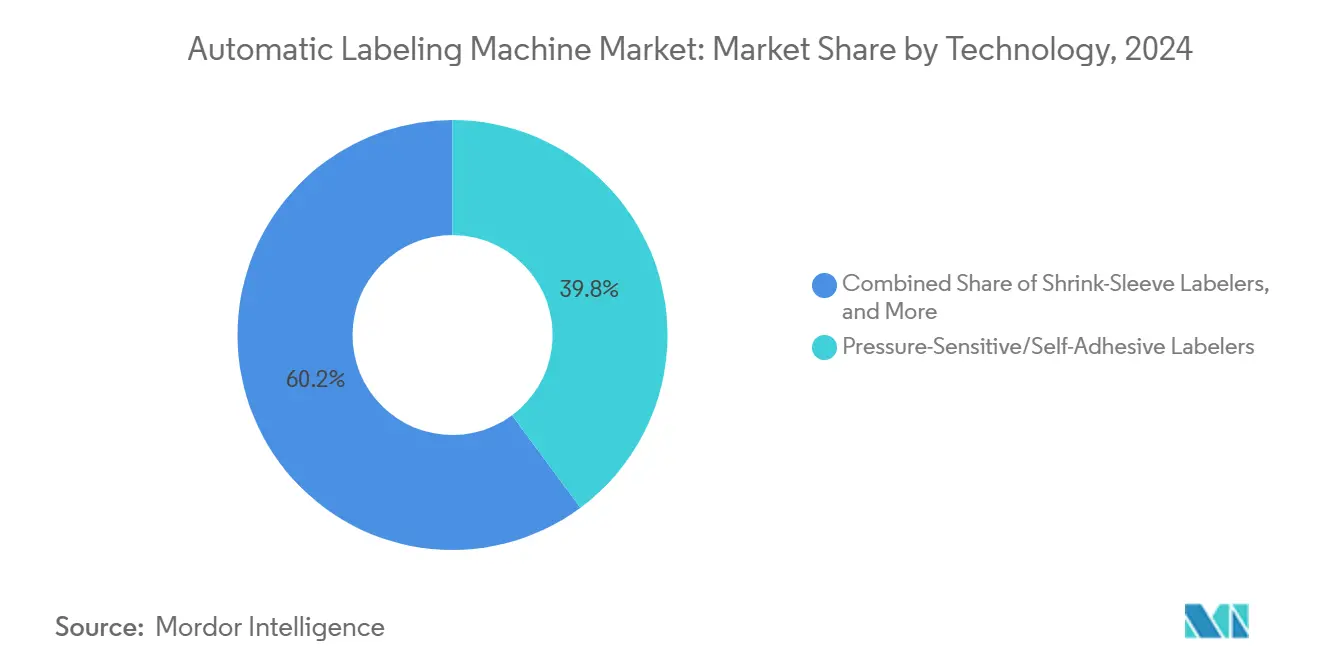
Note: Segment shares of all individual segments available upon report purchase
By Machine Configuration: Modular Systems Challenge In-Line Supremacy
In-line equipment captured 62.54% of 2024 unit sales, underscoring its role as the baseline for high-speed bottling, canning, and case-packing lines. That position equals the largest component of the automatic labeling machine market share. Yet modular/hybrid architectures are rising at 6.36% CAGR as producers prioritize format agility for shorter product cycles. Servo indexers plus slide-in applicator heads let operators swap from wrap-around to top-apply in under 10 minutes. Rotary carousel machines remain essential for 50,000-bottles-per-hour beer plants, but servo-based linear platforms now reach similar speeds while easing size-part complexity.
Configuration decisions increasingly hinge on digital connectivity. Users want embedded OPC UA or MQTT gateways to stream OEE data into MES dashboards, favoring suppliers with proven Industry 4.0 libraries. Print-and-apply modules dominate e-commerce hubs where variable data drives each label, while collaborative robots mount label heads on mobile bases to support multi-line flexibility. Vendors distinguish offers through predictive-maintenance algorithms that flag glue-heater faults or web-break probability, trimming unplanned downtime under tight fulfillment SLAs.
By Labelling Speed: High-Speed Applications Drive Premium Segment
The 61-200 BPM tier held 45.34% of revenue in 2024, reflecting mainstream food and household-chemicals volumes. That slice equals USD 1.39 billion of the automatic labeling machine market size. Demand concentrates in North America and Western Europe, where midsize processors automate legacy lines. Meanwhile, 201-400 BPM systems show a robust 7.07% CAGR as beverage giants and vaccine plants consolidate output into mega-lines above 80% OEE. More than 400 BPM, purchases involve custom engineering, redundant applicator turrets, and dual-lane conveyors to protect uptime.
Speed selection no longer rests only on nameplate ratings. Producers weigh integration rhythm with fillers, cappers, and secondary-packaging robots to avoid starved or blocked stations. Servo-controlled pitch mechanisms now allow variable in-feed pacing, enabling one machine to span slow craft SKUs and mass-run flagship products. High-speed tiers bundle inline camera arrays, checking barcode readability within 50 milliseconds, ensuring regulatory pass rates without halting production.
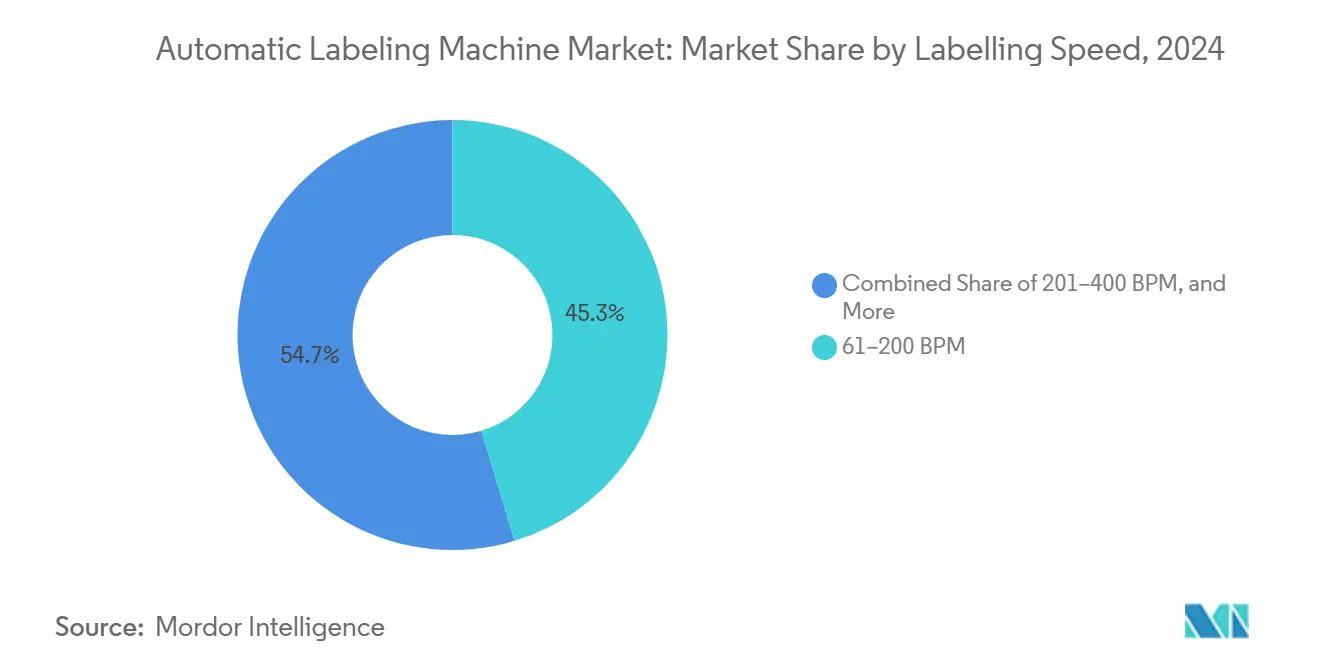
Note: Segment shares of all individual segments available upon report purchase
By End User: Pharmaceutical Growth Outpaces Beverage Leadership
Beverage brands consumed 27.45% of shipments in 2024 owing to global soft-drink and beer volumes. Pharma lines, while smaller in absolute machines, will rise 7.68% CAGR on sustained serialization enforcement and biologics scale-up. Their compliance-driven budgets make pharmaceutical plants a high-margin vertical for suppliers offering audit-ready validation packets. Personal-care producers adopt decorative foil and tactile varnish labels to support premium SKU rollouts and to switch away from secondary cartons.
E-commerce logistics emerges as the stealth growth engine. Fulfillment centers equip print-apply heads that process 150+ cartons a minute, each with variable dimensions. The automatic labeling machine market continues to diversify as contract packagers demand all-purpose lines that can pivot from vitamins one week to gourmet sauces the next, forcing equipment builders to design in multi-format capability from day one.
Geography Analysis
Asia-Pacific generated 40.36% of global revenue in 2024 and preserves first-place momentum with a 6.35% CAGR to 2030. Surging beverage-plant modernization in China and serialization compliance in India underpin big-ticket projects exceeding USD 20 million per facility. Japanese and South Korean factories, pressured by labor shortages, install AI-assisted vision and predictive-maintenance suites to maintain OEE above 85%. Southeast Asian contract packagers multiply as multinational CPG firms regionalize supply chains, boosting mid-range labeler purchases.
North America’s demand remains regulatory-driven. The Drug Supply Chain Security Act sets firm milestones through 2027, keeping a steady pipeline of retrofit and greenfield pharmaceutical orders. Craft beverage producers in the United States and Canada account for many modular system deployments owing to brisk SKU turnover. Sustainability pushes, such as California’s recycled-content mandate, encourage linerless adoption and recyclable adhesive chemistries, fostering pilot projects with universities and equipment OEMs.
Europe exhibits modest headline growth yet commands high specification levels. German brewers spend heavily on carousel machines surpassing 60,000 BPH, while Italian cosmetics plants adopt sleeve-over-sleeve techniques for premium finishes. EU circular-economy targets accelerate linerless and wash-off label uptake, spurring suppliers to certify carbon footprints at quote stage. Eastern Europe, buoyed by near-shoring electronics and automotive supply chains, upgrades to print-apply systems that comply with hazardous-substance transport labels.
Latin America, Middle East, and Africa remain opportunity pockets. Brazil’s USD 231 billion food sector invests in semi-automatic units to lift packaging consistency for exports to the United States and EU.[3]U.S. Department of Agriculture, “Food Processing Ingredients Annual: Brazil,” apps.fas.usda.gov Mexico’s label market will stretch from USD 1.31 billion in 2025 to USD 1.62 billion by 2030, rewarding vendors who offer Spanish-language HMIs and regional service depots. Gulf States beverages and African agro-processors pilot cloud-linked labelers to compensate for scarce on-site engineering talent, using remote diagnostics via satellite connections where broadband is unreliable.
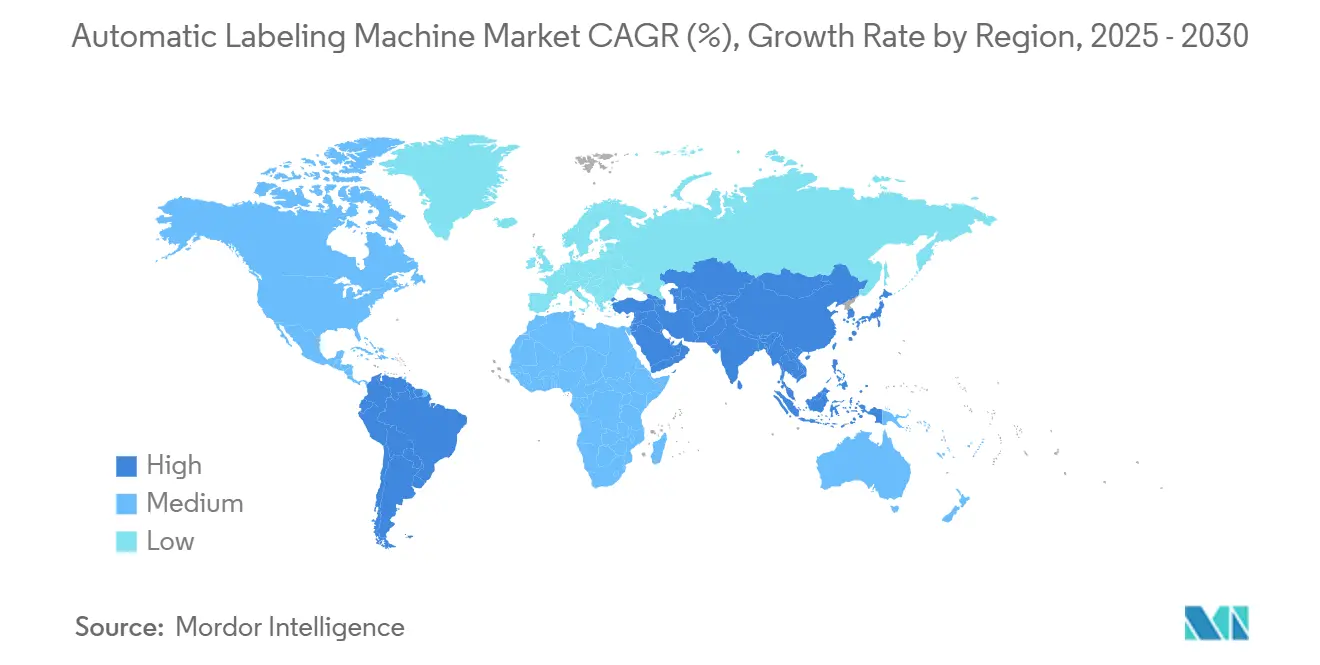
Competitive Landscape
The automatic labeling machine industry is moderately fragmented. The top five suppliers control roughly 45-50% of revenue, leaving room for specialist entrants. Krones booked EUR 5.29 billion in 2024 revenue, citing high beverage automation demand and a EUR 4.29 billion order backlog that secures visibility through 2025.[4]Krones, “Corporate News Release – Improved 2024 Financials,” krones.comSidel and KHS exploit integrated filler-labeler-wrapper proposals, locking in multi-line conversions for flagship breweries. Medium-sized innovators such as Weiler Labeling Systems dominate pharmaceutical serialization niches with turnkey validation documents, while ProMach’s ID Technology grows via targeted acquisitions like Etiflex to boost RFID expertise.
Competition increasingly favors software credentials. Firms roll out AI algorithms that forecast glue pump failure 48 hours ahead or detect missing variable data at 600 BPM. Patent filings revolve around multi-purpose decking plates, tamper-proof RFID tagging, and on-the-fly label-stock splicing that cuts web breaks by 70%. Sustainability differentiators-linerless paths, bio-based films, and low-temperature adhesives draw procurement preference from major FMCG groups. Robotics-as-a-Service models emerge, allowing capex-averse plants to rent collaborative label-placement cells fully maintained by the OEM. Such digital-service emphasis may shift leadership from mechanical powerhouses to hybrid mechatronics-software players within this decade.
Strategic consolidation continues. Omnia Technologies added ACMI and SACMI Beverage & Labelling units in 2024, forming a platform with blow-molding, filling, and labeling under one roof. Krones’ move to acquire Netstal expands into injection-mold capabilities, reinforcing PET lifecycle control. ProMach’s dedicated Wine & Spirits Solutions Group illustrates vertical specialization, where tailored workflows and aesthetic label finishes command higher margins. Collectively, these plays confirm an arms race to own more process steps and supply aftermarket analytics subscriptions, intensifying rivalry yet raising the innovation bar for new entrants.
Automatic Labeling Machine Industry Leaders
-
Krones AG
-
Nita Labeling Systems
-
Bobst Group SA
-
KHS GmbH
-
Accutek Packaging Company, Inc.
- *Disclaimer: Major Players sorted in no particular order
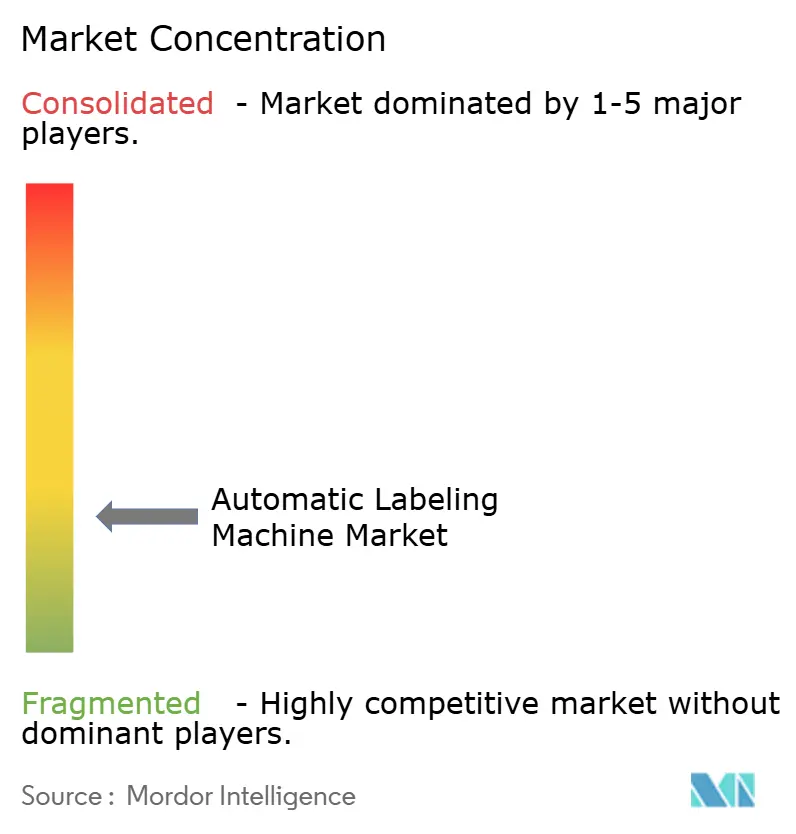
Recent Industry Developments
- May 2025: Krones reported 12.1% revenue expansion to EUR 5.29 billion, with a EUR 4.29 billion backlog signaling sustained beverage-automation demand.
- April 2025: UPM Raflatac began issuing product carbon footprints in every quote, enabling packaging buyers to quantify scope-3 emissions.
- March 2025: ProMach’s ID Technology bought Etiflex, enlarging pressure-sensitive and RFID label capacity in Mexico.
- February 2025: ProMach formed a Wine & Spirits Solutions Group focused on specialized processing and labeling systems.
- November 2024: Krones agreed to purchase Netstal for EUR 200 million, adding injection-molding to its portfolio.
- October 2024: UPM Raflatac launched OptiCut WashOff linerless label stock to aid plastic reuse targets.
Global Automatic Labeling Machine Market Report Scope
Automatic labeling machines are specialized equipment designed to apply labels to products or packaging with minimal human intervention. They streamline the labeling process, increasing efficiency and accuracy in various industries, such as manufacturing, food and beverage, pharmaceuticals, and logistics. These machines can handle multiple label types, including pressure-sensitive, shrink sleeves, and wrap-around labels. They can apply labels to various product shapes and sizes, from small vials to large containers. Automatic labeling machines often incorporate advanced features such as barcode printing, vision systems for quality control, and integration with production line management systems.
The automatic labeling machine market is segmented by technology (pressure-sensitive/self-adhesive labelers, shrink sleeve labelers, glue-based labelers, sleeve labelers, and other technologies), end user (food, beverages, pharmaceuticals, personal care, chemicals, and other end users), and geography (North America (the United States and Canada), Europe (the United Kingdom, Germany, France, and Italy), Asia (China, India, Japan, and Australia and New Zealand), Latin America (Mexico and Brazil), and the Middle East and Africa (United Arab Emirates, Saudi Arabia, and South Africa)). The report offers market sizes and forecasts in value (USD) for all the above segments.
| Pressure-Sensitive / Self-Adhesive Labelers |
| Shrink-Sleeve Labelers |
| Glue-Based (Cold, Hot-Melt) Labelers |
| Sleeve (Stretch, Heat) Labelers |
| In-mold Labelers |
| Other Technologies |
| In-line Labeling Machines |
| Rotary / Rotary-Servo Labelers |
| Print-and-Apply Systems |
| Modular / Hybrid Systems |
| less than 60 BPM |
| 61-200 BPM |
| 201-400 BPM |
| More than 400 BPM |
| Food |
| Beverages |
| Pharmaceutical |
| Personal Care and Cosmetics |
| Chemicals and Industrial |
| Logistics and E-commerce |
| Other End Users |
| North America | United States | |
| Canada | ||
| Mexico | ||
| Europe | Germany | |
| United Kingdom | ||
| France | ||
| Italy | ||
| Spain | ||
| Russia | ||
| Rest of Europe | ||
| Asia-Pacific | China | |
| India | ||
| Japan | ||
| South Korea | ||
| Australia and New Zealand | ||
| Rest of Asia-Pacific | ||
| Middle East and Africa | Middle East | United Arab Emirates |
| Saudi Arabia | ||
| Turkey | ||
| Rest of Middle East | ||
| Africa | South Africa | |
| Nigeria | ||
| Egypt | ||
| Rest of Africa | ||
| South America | Brazil | |
| Argentina | ||
| Rest of South America | ||
| By Technology | Pressure-Sensitive / Self-Adhesive Labelers | ||
| Shrink-Sleeve Labelers | |||
| Glue-Based (Cold, Hot-Melt) Labelers | |||
| Sleeve (Stretch, Heat) Labelers | |||
| In-mold Labelers | |||
| Other Technologies | |||
| By Machine Configuration | In-line Labeling Machines | ||
| Rotary / Rotary-Servo Labelers | |||
| Print-and-Apply Systems | |||
| Modular / Hybrid Systems | |||
| By Labelling Speed | less than 60 BPM | ||
| 61-200 BPM | |||
| 201-400 BPM | |||
| More than 400 BPM | |||
| By End User | Food | ||
| Beverages | |||
| Pharmaceutical | |||
| Personal Care and Cosmetics | |||
| Chemicals and Industrial | |||
| Logistics and E-commerce | |||
| Other End Users | |||
| By Geography | North America | United States | |
| Canada | |||
| Mexico | |||
| Europe | Germany | ||
| United Kingdom | |||
| France | |||
| Italy | |||
| Spain | |||
| Russia | |||
| Rest of Europe | |||
| Asia-Pacific | China | ||
| India | |||
| Japan | |||
| South Korea | |||
| Australia and New Zealand | |||
| Rest of Asia-Pacific | |||
| Middle East and Africa | Middle East | United Arab Emirates | |
| Saudi Arabia | |||
| Turkey | |||
| Rest of Middle East | |||
| Africa | South Africa | ||
| Nigeria | |||
| Egypt | |||
| Rest of Africa | |||
| South America | Brazil | ||
| Argentina | |||
| Rest of South America | |||
Key Questions Answered in the Report
What is the current value of the automatic labeling machine market?
The automatic labeling machine market stood at USD 3.06 billion in 2024 and is forecast to reach USD 3.74 billion by 2030 at a 3.51% CAGR.
Which technology segment grows fastest?
Sleeve labeling systems are expanding 5.65% CAGR through 2030 as beverage brands seek 360-degree graphics and tamper evidence.
Why is Asia-Pacific the leading region?
Asia-Pacific holds 40.36% share thanks to large-scale beverage modernization in China and robust pharmaceutical serialization investments in India, driving a 6.35% regional CAGR.
How do pharmaceutical regulations affect equipment demand?
FDA and EMA serialization mandates require high-precision labelers with vision inspection and data-integrity features, fueling a 7.68% CAGR in pharmaceutical applications.
What sustainability trends influence machine purchases?
Adoption of linerless labels and wash-off adhesives trims waste and supports carbon targets, prompting buyers to favor systems compatible with these eco-friendly materials.
Page last updated on:
.webp)


